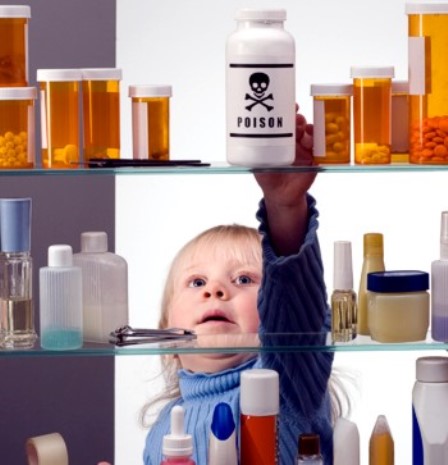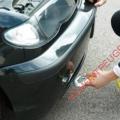In order for a first-aid kit to really be useful, it must be formed consciously, and not spontaneously. That is, you should approach filling the first-aid kit as planned, with a compiled list of necessary medicines for the groups of the most common diseases. Let's figure out what medicines should be in the home medicine cabinet and make an appropriate list.
Before moving on to the list of necessary medicines, I would like to briefly mention the rules for maintaining a home first-aid kit:
Rule 1. Keep the first aid kit out of the reach of children.
Rule 2. Keep medicines in packages, do not throw away the instructions, so that they are always at hand.
Rule 3. Keep track of the expiration date of drugs, update the first-aid kit every year.
Home first aid kit
Well, now about the most important thing: what should be in the first aid kit.
Let's start with dressings and medical devices. So, the most essential sanitation facilities include:
- 2 bandages (elastic and sterile);
- cotton wool (cotton balls, cotton swabs);
- several types of plasters (bactericidal and simple);
- dressing scarf or hemostatic tourniquet in case of need for serious bleeding;
- thermometer;
- pipette;
- it would be nice to have a tonometer.
Now, with regard to medicines. The most commonly used first aid medicines for various ailments include the following medicines:
1. Problems with the stomach or intestines
- with spastic pain in the intestines and nausea, preparations with anise and mint, as well as preparations containing enzymes, help. Such drugs include no-shpa.
- remedies for diarrhea: you can take imodium or drugs containing the substance loperamide.
- Combined herbal preparations, for example, senade, can help with constipation.
- with food poisoning by one of better means is activated carbon or an adsorbent suspension in sachets Enterosgel.
- with heartburn: antacids are used, for example, you can use malox, gastal.
2. Injuries and injuries
- in case of stretching or dislocation: ointments or gels with diclofenac, ortofen, ibuprofen, indomethacin. Herbal preparations with arnica, camphor solution and menthol are also used.
- remedies for wounds and cuts: traditional iodine and brilliant green are best purchased in the form of markers.
- for burns: the well-known "Rescuer" or propolis alcohol solution helps well.
3. Colds and SARS
- for pain and temperature: aspirin, paracetamol. At the pharmacy, you should choose the option that is right for you.
- for colds: nasal drops or aerosols to make breathing easier, cough syrup or mouthwash.
- sucking herbal lozenges or stronger medications such as neoangin work well for sore throat.
- with a productive cough, ambroxol or bromhexine will help, and with a dry cough - codelac and sinecode.
4. Heart and sedatives
- if you have heart problems, then you need validol, nitroglycerin, valocordin or corvalol.
- if you are often worried or cannot sleep, then valerian drops will help you.
5. Allergy
- in case of allergies, you can take medicines containing the substances loratadine, cetrin (claritin, zyrtec).
And of course don't forget about folk remedies, each of us must have several family recipes in stock. In addition to the means of the most frequent use, do not forget about your individual "sores" and always keep special medicines with the rest in your home medicine cabinet.
It is advisable to group all these drugs into containers (boxes, baskets), each signed in accordance with the medical problems for the treatment of which they are intended.
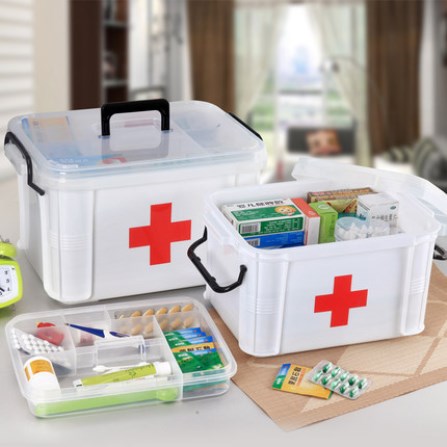
You can hang a leaflet on the door of your medicine cabinet listing all the components that make up the medicine cabinet. This way you will always know what products you have in stock.
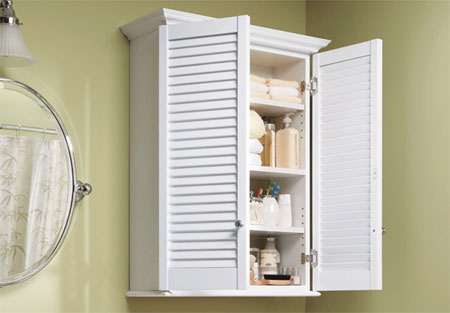
Every housewife and homemaker should have a first aid kit at home, which will come to the rescue in various emergency (and not only) situations. It is necessary to equip such a first-aid kit based on the characteristics of each family, the presence of chronic diseases, allergies, frequent colds, dislocations and other ailments in family members. But this is not the only issue that needs to be addressed. It is important to choose the right place to store your home first aid kit, taking into account a number of nuances. So, if there are small children in the house, then their access to the first aid kit should be limited. You should also choose a place with the lowest humidity and closed from the penetration of sunlight. This is necessary to extend the life of medicines, to avoid mold or discoloration. So what is the best place to store a home first aid kit?
There are several good options. First of all, this is a drawer of a chest of drawers, bedside tables in a bedroom, kitchen or corridor. Its advantages are protection from sunlight, dryness and ease of use.
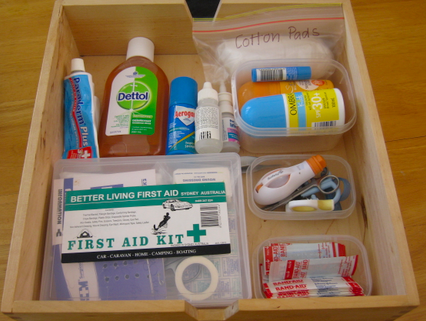
However, one box, if it is small, will not be enough. It is best to select two or three drawers (for example, in a plastic chest of drawers), sorting medicines, ointments, bandages and other components of the first aid kit according to their importance.
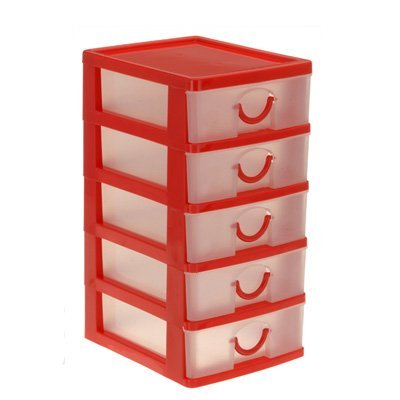
In addition to a drawer, a hanging cabinet or a cabinet with many small shelves will be an excellent place to store a first aid kit.
In this case, it is convenient to organize a first-aid kit in the form of several transparent containers or resealable plastic boxes.
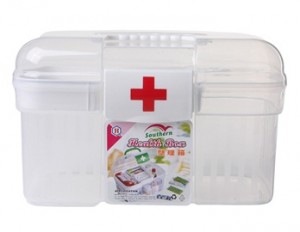
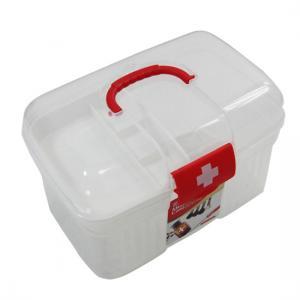
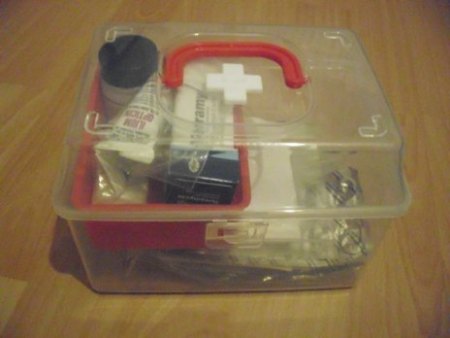
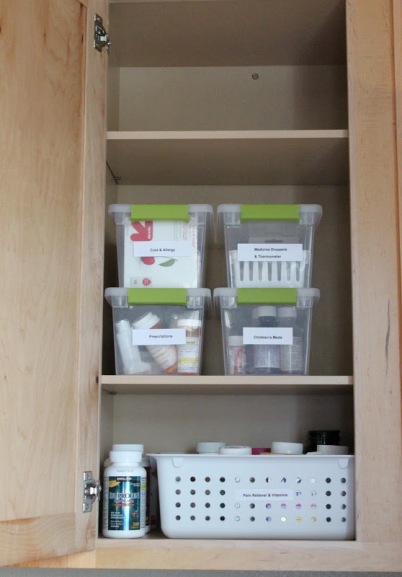
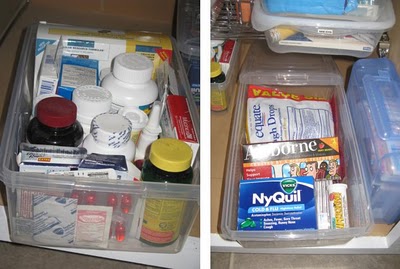
These can be small boxes in which medicines and first aid supplies will be sorted according to their purpose: remedies for colds and runny nose, headache, abdominal pain, ointments for sprains and dislocations, universal remedies (brilliant green, iodine, peroxide, bandages and plasters) and so on.
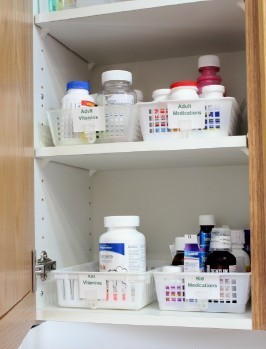
For convenience, containers can be signed or brightly labeled with labels.

Along with the boxes, it is convenient and beautiful to store the first-aid kit in wicker or plastic baskets.
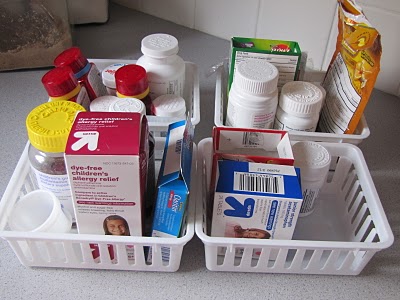

They are suitable for placement in a wooden cabinet or on a dedicated open rack.
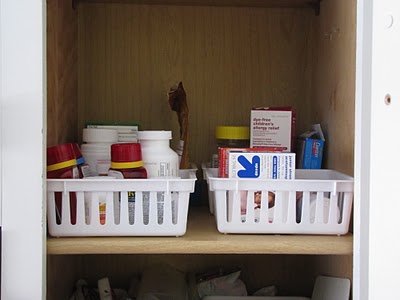
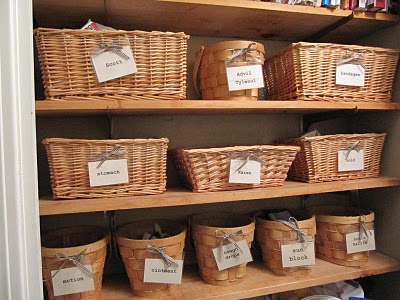
Do not forget that this option is suitable for those who do not have small children (after all, curious kids can get to unsafe drugs).
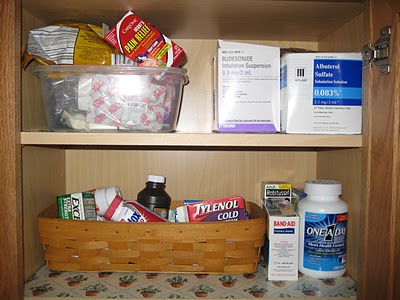
In case you need to keep the first aid kit out of the reach of children or if you need to take pills on a schedule, then a special pill box is perfect for you. It is a mini-suitcase or purse with a fastener and provided compartments for certain drugs.
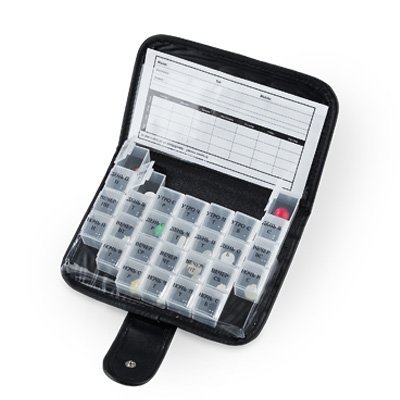
It is very convenient to have such a pill box as an express aid that you can take with you on a trip or, if necessary, to nature.
Another option for storing a home first aid kit is fridge.

However, it should be used with extreme caution for this purpose.
First, it's easy accessibility (again - small children).
Secondly, not all drugs can be stored in such a cold place (they can lose their properties, freeze).
And, thirdly, for medicines, you need to allocate a separate shelf (compartment) in the refrigerator, and not place them next to food and drinks. Caution in this matter will not be superfluous.
By the way, have you seen that special cabinets with glass doors hang in the offices of clinics? This (or similar) can be purchased at home. It is very convenient when all medications are visible at a glance.
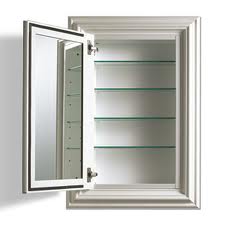
It is best to hang it in the kitchen or closet, if there is one, so as not to expose the first-aid kit to guests and not to spoil the interior of the apartment.
These are, in general, the main options for storing a home first aid kit. Agree, choose appropriate place in your home is not at all difficult, but very important.
Even if you closely monitor your health, you will not be able to insure against everything at once.
And yet, every family should have its own first aid kit. What is it for people without medical education? To have time to render the first medical assistance before the arrival of the local doctor or ambulance team.
Putting things in order
Headache, fever, pain during menstruation, indigestion and similar problems are common in health complaints. And although no one is safe from them, with the right approach to the contents of a home first aid kit, you can significantly reduce the discomfort.
Before putting together a first aid kit, it's best to put things in order in what you already have. Throw away old medicines that have passed their expiration date. In addition, you should not keep medicines in the bathroom or, for example, in the kitchen near the gas stove. High humidity does not affect the preparations in the best way, therefore it is better to store them in a dry, cool and dark place.
The first aid kit should contain exactly those medications with which you can provide first aid. You shouldn't buy very expensive medicines. And of course, you should know what to take for which ailment.
Basic storage rules
Medicines should never be exposed to sunlight.
Before you put drugs in storage, pay attention to the instructions. It should say at what temperature they can be kept at home. Some products can be stored at room temperature, while others, for example, need to be refrigerated.
Do not throw away medication annotations. It will be better if they fit in the same box with the drug in order to avoid poisoning and other more serious consequences.
Once every six months, review the medicines in your home medicine cabinet, check the expiration dates. Throw out expired medications without regret. In order to have everything at hand at a critical moment, try to replenish the missing funds in advance.
And finally, the main rule: keep medications as far as possible from young children. Adult negligence can lead to tragedy.
Rapid response tools
It makes sense to place them in the kitchen, finding a dark place without high humidity... Why? According to statistics, it is in the kitchen area that most of the household injuries occur. The cuts and burns we get while cooking can be very serious! Therefore, prepare the following items and medicines:
* Hydrogen peroxide 3%.
* Burn remedy, better spray.
* Alcohol - for treating wounds.
* Bandage - preferably two, one sterile, the other normal.
* Zelenka or iodine.
* Scissors.
* Antihistamines.
Leaders of the "hit parade" of home medicines
What other things and medicines are definitely worth keeping at home? Here's a rough list:
Thermometer
It should be in every home. An increase in body temperature is associated with many diseases, so you cannot do without a thermometer - it will help you check if everything is in order at any time.
Antiseptic
Soap and water may be sufficient to clean the skin around a minor scratch or cut. But to significantly reduce the risk of infection, it is worth using an antiseptic. Hydrogen peroxide or rubbing alcohol is fine.
Acetylsalicylic acid (aspirin) and paracetamol
These medicines are primarily needed for colds and flu. They are used to lower body temperature, and you cannot do without their presence in your home medicine cabinet.
Adhesive plaster
Most scratches heal well on their own, but if the scratch is located so that dirt can get into it or it will be constantly rubbed with clothes, then it is worth using an adhesive plaster.
Dental floss
When you brush your teeth without flossing, you are not cleaning your mouth 100%. In fact, without dental floss, you are depriving yourself of preventing gum disease, which is the leading cause of tooth loss in adults.
Muscle cream
A muscle ache cream to soothe tired muscles or lower back pain is a must. Of course, it is worth using such creams with caution, since some of them contain ingredients that can be harmful in case of an overdose.
Sterile gauze
Gauze or a bandage will come in handy in case of damage more serious than a paper cut, in which there will already be little adhesive plaster. Just remember to change the dressings and consult your doctor in case of particularly deep cuts.
Scoop
The effect of drugs directly depends on the dosage, so taking liquid drugs by measuring them "by eye" can be not only ineffective, but also dangerous.
Cough tablets and syrups
Cough is one of the main symptoms of colds, and the common cold is the most common ailment that happens often and takes us by surprise. Such medicines are an indispensable remedy, especially if you have a high fever and you can no longer easily run to the pharmacy yourself.
Ascorbic acid (vitamin C)
A universal remedy for boosting immunity and shock fighting infection.
Soothing remedies: tincture of valerian, motherwort
Many people today experience stress on a daily basis. Therefore, if you often need to calm down quickly in order to fall asleep in the evening, such medications are necessary.
Drugs used for abdominal pain and poisoning
Activated carbon or smecta are the most popular remedies for food poisoning. If after taking them does not get better, you should see your doctor.
Pain relievers
For severe headache or toothache, analgin and citramone will help. Just do not abuse them at the slightest ailment.
Tweezers
Tweezers and tweezers can be very useful for removing various problematic splinters. However, you can find a lot of applications for them, and therefore it is definitely worth keeping on hand.
Antifungal drugs
If you find fungus on your nails, do not wait until it starts giving you very serious trouble. Remember that fungal infections are difficult to treat, so it is worth going to the hospital.
Everything is at hand!
It is good if your first aid kit will be with you not only at home, but also during outdoor recreation or travel. When purchasing medications at a pharmacy, consider your own characteristics, if they can lead to the difficulty of going to it, especially if a person lives alone. Have the essentials ready in advance.
And don't forget - the first aid kit must be out of the reach of children and pets.
Discussion
I took this (for myself and the child):
1 thermometer (mercury and / or digital);
2aspirator for nose
3 eye pipette - 3 pcs
5 drinking soda
7 potassium permanganate
8 hydrogen peroxide
9grass
10yod
11 rubber band
12 clutch wide and narrow sterile
13Sterile gauze wipes
14vat
15 adhesive plaster
16paracetomol-containing preparation
17 activated carbon
18smect
19antiallergic agent (suprastin, tavegil or claritin in syrup)
20no-shpa.
23 Dr. Mom (lozenges and ointment)
24cough syrup (for children)
25 Remedies for mosquitoes, after bites Fenistil
27 "BF" medical adhesive film on iodine basis
29Valerianachel
30 Cotton buds
32Rehydron
Bifidumbacterin forte
Streptocide
Rescuer
Syringe
This is from the conference
Topic: First aid kit - continuation
These are the drugs that have turned out so far ... Additions - will there be changes? :)))
Antipyretic: Eferalgan suppositories, Nurofen syrup, Calpol, Ibuprofen, analgin suppositories, Panadol.
Stomach: Glycerin suppositories, activated carbon, smecta, rehydron. Festal / mezim - enzymes, immodium, no-shpa, linex, maalox, hilak drops,
Against intestinal infections - furazalidone or ersefuril, acipol tablets and viferon suppositories (viral intestinal infections). Rehydron (for dehydration)
Runny nose: tizin, IRS-19; cub - protargol (collargol), nasivin, derinat, peach oil
Cough: licorice, doctor mom, children's cough medicine with marshmallow root, gedelix, hexoral (from the throat), bromhexine, bioparox, dry cough medicine.
Antihistamines: fenistil, claritin, suprastin, tavegil, euphyllin
Antiviral: oxolinic ointment, interferon,
Immune: aflubin, immunal, viferon,
Injuries: hydrogen peroxide, iodine, brilliant green, "Rescuer", panthenol ointment (for burns), hemostatic crandash, sea buckthorn oil, potassium permanganate,
Items: thermometer, enema, nasal aspirator, bandages, plaster, cotton wool, pipette, gauze, heating pad, rubber band, paper for compresses, erased napkins, bandages, cotton swabs, surgical (!) Adhesive plaster and ordinary (better with brilliant green) , syringes,
Teeth: kalgel, viburcol candles
Eyes: Actovegin gel
Vitamins: ascorbic acid, multitabs
Zinc ointment, medical alcohol, drinking soda, synthomycin emulsion,
Herbs: chamomile flowers, mother and stepmother (expectorant for coughing); plantain leaf;
linden (home antipyretic agent for children from 2 years old); dry raspberry, eucalyptus
I wanted to add annotations, but I'll just give you links, otherwise it turns out too much ...
19.11.2002 13:41: 4, KengaRu
To answer
Not quite correct :)
eferalgan, Calpol, Ibuprofen, Panadol are synonyms for paracetamol (commercial names for paracetamol-containing drugs). So it's better to write "paracetamol" in candles and syrup.
11/19/2002 15:36:35, Akka_Kebnekaise
To answer
Again, a small change: ibuprofen or nurofen is not a paracetamol-containing drug. These drugs (paracetamol and iburofen \u003d nurofen) are from the same group, the so-called. non-steroidal anti-inflammatory drugs.
All of them have antipyretic, anti-inflammatory and analgesic effects.
11/19/2002 21:20:18, Olga B
To answer
Stop, stop, stop - ibuprofen is not paracetamol! The active substance in it is called ibuprofen (the medicine can also be called nurofen) - it is from a completely different range of active substances than paracetamol.
11/19/2002 20:49:40, Tushkan
To answer
I thought too, but then I decided to write commercial names - so that everyone could choose for themselves what suits him, already specifically ... General composition after all, it is different, someone is allergic to certain components, something does not help someone ... I just want to collect a general set, and specifically each one will choose for himself. :)
11/19/2002 15:54:34, KengaRu
To answer
Tady should be written "or" everywhere. Padadol or colpol type; "Solcoseryl" or "Rescuer". Otherwise, people will buy everything and it will gather dust until the expiration date ...
11/19/2002 16:16:40, Akka_Kebnekaise
To answer
write this way, it will be clearer that these are substitutes.
11/19/2002 17:10:42, fina
To answer
Let there be commercial names, I don't know that these drugs all contain paracetamol, it's easier for me to navigate by the name :)
19.11.2002 15: 45: 0, fina
To answer
Yes, they do not contain paracetamol, but they consist of paracetamol :) And so you come to the pharmacy, ask for a specific name - it will not be there, and you will leave with nothing. Although it would be possible to take a similar drug from another company.
And in general, IMHO, if you really give something to a child without a doctor's prescription, then at least you need to clearly understand what it is and what it is eaten with.
11/19/2002 16:15:19, Akka_Kebnekaise
To answer
In, golden words! That's why I want to collect who uses what, in order to know approximately, and then by the annotations it will be possible to see what exactly suits your child, just different names are needed to make it clear what to look for. For this, the drugs are divided into sections.
11/19/2002 17:10:43, KengaRu
To answer
panthenol oil, and spray, as far as I know. and in the gastric preparations, I still would add a group of bacteria - bactisubtil, linex.
for the eyes, I would still keep the albucide solution in case to rinse if dirt gets in.
you can also add a series of herbs to the herbs (for all kinds of dermatitis)
11/19/2002 14:12:43, Danilkina's mother
To answer
Notes: Immune \u003d Antiviral
Viburcol suppositories - homeopathy, is an analgesic and antipyretic
Eyes: required: albucid !!!
Instead of activated charcoal - enterosgel
The saline solution was forgotten (although you can make it yourself, but pharmacy-sterile is better)
Safety pipettes (with rounded tip)
From burns (I remembered after all!) Solcoseryl. It helps a lot.
11/19/2002 14: 5: 41, T_Yana
To answer
Solcoseryl not only from burns, it is a wound healing - super! (you can instead of the Rescuer)
About enterosgel - I confirm, thing!
11/19/2002 15:31:15, Akka_Kebnekaise
To answer
Thanks! Thank you all, otherwise I have one hand with the child, the other is on the computer, and the brains are not the same :)))
11/19/2002 14:27:50, KengaRu
To answer
i asked yesterday - solcoseryl? but you didn’t admit: ((can you please?)
11/19/2002 14:15:33, Danilka's mother
To answer
And I was already drowning home :) it is possible for you, even nuna!
11/19/2002 14:20:53, T_Yana
To answer
Minor edit: aminophylline is not an antihistamine. It expands the bronchi, refer it to the "cough" group.
11/19/2002 13:56:56, Olga B
To answer
yes prescribed for bronchitis or croup.
11/19/2002 14: 3: 32, Kalina
To answer
Did you know:
what medications do you need and do not need to keep in your home medicine cabinet?
Undoubtedly, there is a drawer in your home (bag, cabinet, shelf, etc.) that you call a "first aid kit". Its content can tell a lot about the owner. In most cases, it is filled with medicines and other items. medical purpose, left over from the treatment of past diseases, wounds inherited from visiting relatives, and at that very moment it turns out that the most necessary things are not there, and if there is, then the expiration date has passed in the last five years. But you could prudently stock up on the essentials. Of course, there is no need to buy up the entire pharmacy - it is expensive, and then it will be a pity to throw out expired medicines.
There are many different listings for a home first aid kit. Immediately discard the lists of the Soviet era - they are outdated - now on the pharmaceutical market there are no many drugs of those times, and even if you start looking for them, the young generation of pharmacists may not know how to replace them. New medicines appear every year, sometimes much more effective or less harmful, children's dosage forms, etc.
Lists from foreign sources, of course, will not be useful to you either - the range of pharmacies, the principles of treatment, and the entire health care system (not to mention the general lifestyle) are very different from the domestic one.
There remain only modern domestic sources - unfortunately printed publications - modern domestic ones - less than a cat cried, an information leaflet in a hospital or a pharmacy may be useful, and even better - the advice of your friend's doctor (better a therapist), and even better a pharmacist. Of course, the doctor knows better the ambulance schemes, but the medicinal assortment, its rating, and what is no less important - the prices and availability, of course, the pharmacist is the person who deals with this. Let me be your familiar pharmacist. Of course, the list will not be absolutely universal (health, illness, and knowledge base are different for all of us), and you may even make your own adjustments.
Try not to buy into ads. Advertising is the engine of commerce, and that says it all. Of course, infomercials played a big role in raising the farm. literacy of the population, but do not rush to lay out your hard-earned money for beautiful promises.
As in many life situations, the secret of success is knowledge + logic + experience + systematicity. It is not necessary for everyone to be a certified physician; often it is enough to know where to get competent and prompt (and understandable) information. Undoubtedly, you have logic, and experience is a gain. The content of the first-aid kit is not inferior to the content of your refrigerator - under certain conditions it can even save your life - for you and your loved ones, and much less or no attention is paid to it (the first-aid kit). Of course, you are busy with work, household chores, etc., but 20-30 minutes a month is not that much, especially if you compare how much time we spend on less useful activities - watching soap operas, advertising blocks, contemplating cracks in the ceiling and stains on the wallpaper.
So, for an adult, relatively healthy person, what would it be good to have in a first-aid kit? First, you need to remember what health troubles most often happen:
- runny nose, cold, flu, tonsillitis,
- bronchitis,
- allergies, rashes, irritation from cosmetics and aftershaves,
- cuts, bruises, burns, shoe scuffs,
- sweating feet
- diarrhea, heartburn, heaviness in the stomach,
- stress, pain in the heart area, insomnia, increased irritability and fatigue,
- pain: menstrual, toothache; stomach, intestinal, renal colic.
- Pinosol - the least harmful nose drops with a cold, contains essential oils, menthol (if there is no allergy to menthol and other ingredients), does not dry out, does not constrict blood vessels, well "breaks through" nasal congestion. Do not use vasoconstrictor drops and antibiotic solutions - they have a lot of side effects.
Ektericide - an oily solution of an antiseptic - does not dry out, does not constrict blood vessels, the oily solution covers the nasal mucosa, the substance can stay longer and kill microbes on the mucous membrane. Cons - it is poured into large bottles (200 ml) and after opening is not stored for a long time. I use this method - I buy a large bottle, store it in the refrigerator, and if a runny nose occurs, I take a portion into a penicillin or a plastic dropper with a disposable syringe.
To alleviate the condition for colds it is better to have some kind of multicomponent drug - for example, several sachets of Pharmacitron, Fervex, Antigrippin, high dosage vitamin C (500 mg) - once a day, aspirin or paracetamol - better in the form of effervescent tablets, and alas, better nenashenskie - UPSA, Bayer.
From herbs - linden flowers (diaphoretic, reduces fever), calendula flowers or eucalyptus leaves (for inhalation and gargling).
In case of angina, in addition to rinsing, it is good to use pills or lozenges for sucking, for example, "Faringosept" or "Strepsils".
A gauze mask will help you not to infect others with influenza, and "Oxolinic Ointment" will not get infected yourself during an epidemic.
- Syrup / drops / tablets / dragees from cough - every year there are more and more of them, for example, stoptussin, bromhexin, etc., and even better, marshmallow root syrup or cough syrup. If the sputum is very viscous and does not come off well, ACC helps (in sachets or dissolving tablets). It all depends on the severity, neglect and complication of bronchitis.
Mustard plasters, herbs: coltsfoot leaves, thyme, oregano - in a mixture or separately, or chest collection.
- For allergies drugs for several generations, but we still, like 20 years ago, prescribe the cult diazolin or diphenhydramine, which have a bunch of side effects, especially drowsiness, inhibition of reaction, some are even sure that diphenhydramine is a sleeping pill. Optimally "Claritin". External antiallergic drugs contain hormones, except for Fenistil gel. If you are not sure about the non-infectious cause of the rash (that the rash appeared from washing with a new powder or from using new, not very high-quality cosmetics, if you first ate something especially allergenic, for example, citrus fruits or chocolate), and if the allergy is not severe, it is still better not to take medication, but to see a doctor. A rash occurs with different diseases, and different drugs can "lubricate" the clinical picture of the disease and will be much more difficult to diagnose.
- Necessarily needed in the house means for treating wounds and burns - hydrogen peroxide, brilliant green, iodine (store separately from medicines, rubber, preferably in a glass jar with a hermetically sealed lid) - for an amateur, ointments for healing - "Rescuer", "Healer", "Wundehil", for dressing - bandages - several different widths, sterile napkins, adhesive plasters - reel and with a dozen bactericidal, cotton wool bag for 50-100 g, ear sticks are convenient to use for treating wounds with antiseptics.
- From sweating feet - Teymurov's paste, oak bark for deodorizing baths. It helps if there is no fungal cause of the bad smell from the feet, otherwise you must first be treated for the fungus.
- If digestion is disturbed (diarrhea, rumbling in the abdomen, gases) - "Smecta" package or activated charcoal tablets - adsorbs substances and gases, then do not eat for at least 2 hours, in case of poisoning the dose: 1 tablet per 10 kg of weight. In case of severe diarrhea, dissolve and drink the "Regidron" sachets - from dehydration and replenishment of washed out minerals. Do not use chloramphenicol, furadonin, phthalazole - it is far from harmless. Fosfalugel, Maalox, Gastrogel suspensions in sachets, and in no case soda solution - it will only increase acidity, help to reduce pain in case of heartburn or increase the acidity of gastric juice. If, after a plentiful feast, the stomach is heavy, it is better to take pity on the pancreas and drink the enzymes "Festal", "Enzistal", "Mezim". Herbs: St. John's wort, chamomile.
- In case of heartache it is best to have valerian extract in tablets or tincture in drops, to calm down - Corvalol 15-20 drops on sugar or half a glass of water, you can tincture motherwort 15-20 drops, in case of fainting (and to remove stains) - ammonia solution ( he is ammonia).
- Pain relief is a complex science. Pain sensitivity and effectiveness pain medications - the thing is quite individual, many people are helped from headaches by "Citramon", "Citropac", "Spazmalgon", from dental "Tempalgin", "Baralgin", with menstrual "Ketans", "Movalis". For spasms, colic - "No-shpa", "Spazmalgon" tablets.
Plus to this list, pipettes, several different disposable syringes, a thermometer, a syringe, non-sterile gloves, fingertips, a heating pad, Esmarch mug (or a combined heating pad), plus your specific medications.
Now you are fully armed, it remains to monitor the expiration dates every 1-2 months and replenish running out medicines or honey products. destination.
Write on a piece of paper everything that is in your first aid kit (with expiration dates, if limited) and attach the list to the lid.

